This information explains the procedure to place your CVC, including how to get ready and what to expect. It also explains how to care for your CVC. In this resource, the words “you” and “your” refer to you or your child.
About CVCs
A CVC is a catheter (long, flexible tube) that’s put into a vein in your chest. There are many types of CVCs. Your doctor will decide which type is best for you.
All CVCs have 1 central catheter that’s put into a large vein near your heart. Outside your body, the central catheter divides into 1, 2, or 3 smaller tubes called lumens. Each lumen has a clamp, a needleless connector (sometimes called a clave), and a disinfection cap on the end (see Figure 1).
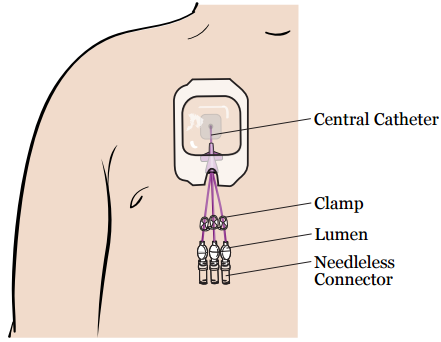
Figure 1. Central venous catheter (CVC)
Having a CVC will help you need fewer needle sticks. Your care team can use your CVC to:
- Take blood samples from you
- Give you fluids
- Give you chemotherapy and other medications
- Give you blood transfusions
- Give you intravenous (IV) nutrition
Your CVC can stay in your body for as long as a few years. It will stay in place for your whole treatment. Your doctor will remove your CVC when you don’t need it anymore.
Having a CVC shouldn’t keep you from doing your normal activities, such as going to school or work, showering, and doing light exercise. Read the section “Caring for Your CVC” for more information.
You’ll have a procedure to place your CVC. Your nurse will tell you how to get ready for your procedure. They’ll also teach you how to care for your CVC after your procedure. You’ll learn to:
- Change your dressing (bandage)
- Change your needleless connectors
- Change your disinfection caps (such as SwabCaps®)
- Flush your CVC
You can have a caregiver, family member, or friend learn with you. After you go home, use this resource to help you remember the steps to care for your CVC.
Before Your Procedure
Ask about your medications
You might need to stop taking some of your medications before your procedure. Talk with your healthcare provider about which medications are safe for you to stop taking. We’ve included some common examples below.
Anticoagulants (blood thinners)
If you take a blood thinner (medication that affects the way your blood clots), ask the doctor who’s doing your procedure what to do.
| Examples of Blood Thinners | ||
|---|---|---|
| aspirin | tinzaparin (Innohep®) | prasugrel (Effient®) |
| warfarin (Jantoven® or Coumadin®) | enoxaparin (Lovenox®) | ticlopidine (Ticlid®) |
| dalteparin (Fragmin®) | clopidogrel (Plavix®) | |
| heparin | cilostazol (Pletal®) | |
Medications for diabetes
If you take insulin or other medications for diabetes, ask the healthcare provider who prescribes it what to do the morning of your procedure. You might need to change the dose before your procedure.
Aspirin and other nonsteroidal anti-inflammatory drugs (NSAIDs)
If you take aspirin, a medication that contains aspirin, or an NSAID such as ibuprofen (Advil® or Motrin®), ask your healthcare provider if you need to stop taking it before your procedure. This will depend on the reason you’re taking it.
For more information, read the resource How To Check if a Medicine or Supplement Has Aspirin, Other NSAIDs, Vitamin E, or Fish Oil. You can find it online or ask your healthcare provider for a copy.
Vitamin E and other dietary supplements
If you take vitamin E, stop taking it 7 days before your procedure or as directed by your healthcare provider.
If you take a multivitamin, any herbal remedies, or any other dietary supplement, ask your healthcare provider if you should keep taking it.
Tell us if you’re sick
If you get sick (such as with a fever, cold, sore throat, or the flu) before your procedure, call your healthcare provider.
1 Day Before Your Procedure
Note the time of your procedure
A staff member will call you the day before your procedure. If your procedure is scheduled for a Monday, they’ll call you on the Friday before. If you don’t get a call by , call 212-639-5948.
The staff member will tell you what time to get to the hospital on the day of your procedure. They’ll also remind you where to go. It will be one of the following places:
-
Pediatric Ambulatory Care Center (PACC)
1275 York Avenue (between East 67th and East 68th Streets)
New York, NY 10065
Take the B elevator to the 9th floor. -
Presurgical Center (PSC) on the 6th floor
1275 York Avenue (between East 67th and East 68th Streets)
New York, NY 10065
Take the B elevator to the 6th floor.
Do not eat any solid foods after midnight the night before your procedure. This includes hard candy and gum.
The Day of Your Procedure
Instructions for drinking before your procedure
You can keep drinking formula, breast milk, and clear liquids after midnight. Follow the instructions in the table below. It’s OK to brush your teeth and take your medications with a small sip of water.
| Type of liquid | Amount to drink | When to stop drinking |
|---|---|---|
| Formula | Any amount | Stop drinking formula 6 hours before your scheduled arrival time. |
| Breast milk | Any amount | Stop drinking breast milk 4 hours before your scheduled arrival time. |
| Clear liquids such as water, fruit juice without pulp, carbonated (fizzy) drinks, tea without milk, and coffee without milk |
| Stop drinking clear liquids 2 hours before your scheduled arrival time. |
Do not drink anything starting 2 hours before your scheduled arrival time. This includes formula, breast milk, water, and other clear liquids.
Take your medications as instructed
If your healthcare provider tells you to take certain medications the morning of your procedure, take only those medications with a sip of water. Depending on what medications you take, this may be all, some, or none of your usual morning medications.
Shower
Shower using your usual soap, shampoo, and conditioner. After your shower, dry yourself off with a clean towel and put on clean clothes. Don’t put on any lotion, cream, deodorant, makeup, powder, perfume, or cologne.
Things to remember
- Wear clean, comfortable clothing.
- If you wear contact lenses, wear your glasses instead. Wearing contact lenses during a procedure can damage your eyes.
- Don’t wear any metal objects. Remove all jewelry, including body piercings. The tools used during your procedure can cause burns if they touch metal.
- Leave valuable items at home.
- If you’re menstruating (have your monthly period), use a sanitary pad, not a tampon. You’ll get disposable underwear, as well as a pad if needed.
What to bring
- A list of the medications you take at home, including over-the-counter and prescription medications, patches, and creams.
- Medications for breathing problems (such as inhalers), if you take any.
- Medications for chest pain, if you take any.
- A case for your glasses or contacts.
- Your Health Care Proxy form and other advance directives, if you’ve completed them.
- Your breathing device for sleep apnea (such as your CPAP or BiPAP), if you have one.
- This resource. You’ll use it to learn how to care for your CVC after your procedure.
Where to park
MSK’s parking garage is on East 66th Street between York and 1st avenues. If you have questions about prices, call 212-639-2338.
To get to the garage, turn onto East 66th Street from York Avenue. The garage is about a quarter of a block in from York Avenue. It’s on the right (north) side of the street. There’s a tunnel you can walk through that connects the garage to the hospital.
There are other parking garages on:
- East 69th Street between 1st and 2nd avenues.
- East 67th Street between York and 1st avenues.
- East 65th Street between 1st and 2nd avenues.
Once you’re in the hospital
When you get to the hospital, take the B elevator to the 9th floor (if you’re going to the PACC) or the 6th floor (if you’re going to the PSC).
Many staff members will ask you to say and spell your name and date of birth. This is for your safety. People with the same or a similar name may be having a procedure on the same day.
When it’s time to change for your procedure, you’ll get a hospital gown, robe, and non-skid socks to wear.
Meet with a nurse
You’ll meet with a nurse before your procedure. Tell them the dose of any medications (including patches and creams) you took after midnight and the time you took them.
Your nurse will place an intravenous (IV) line into one of your veins. The IV line may be used to give you fluids, medication to help you relax during your procedure, or both.
Meet with an anesthesiologist
You’ll also meet with an anesthesiologist before your procedure. They will:
- Review your medical history with you.
- Ask you if you’ve had any problems with anesthesia in the past, including nausea (feeling like you’re going to throw up) or pain.
- Talk with you about your comfort and safety during your surgery.
- Talk with you about the kind of anesthesia you will have.
- Answer your questions about your anesthesia.
Get ready for your procedure
One or 2 visitors can keep you company as you wait for your procedure to start. When it’s time for your procedure, a staff member will bring your visitor(s) to the waiting area.
Before you go into the operating room, you may need to remove your hearing aids, prosthetic devices, wig, and religious items, if you have any.
You’ll either walk into the operating room or a staff member will bring you on a stretcher. A member of the operating room team will help you onto the operating bed. Once you’re comfortable, your anesthesiologist will give you anesthesia through your IV line and you’ll fall asleep.
During your procedure
First, your doctor will give you an injection (shot) of a local anesthetic near your collarbone. A local anesthetic is a medication that makes an area of your body numb. This will help keep you from having pain after your procedure.
Next, your doctor will make 2 small incisions (surgical cuts) called the insertion site and exit site.
- The insertion site is where your CVC will enter your vein. This incision will be just below your collarbone.
- The exit site is where your CVC will leave your body. This incision will be a few inches below the insertion site.
Then, your doctor will place one end of your CVC through the insertion site and into your vein. They’ll tunnel the other end under your skin and out of the exit site. Tunneling your CVC under your skin will help keep it from moving.
After your CVC is in place, your doctor will close the insertion site with Dermabond® (surgical glue) or Steri-Strips™ (surgical tape). They’ll close the exit site with sutures (stitches). They’ll also stitch your CVC to your skin at the exit site so it stays in place until it becomes anchored in the tunnel under your skin. Then, they’ll put on 2 dressings: 1 dressing over your insertion site and 1 dressing over your exit site and CVC.
After Your Procedure
When you wake up after your procedure, you’ll be in the Post-Anesthesia Care Unit (PACU). As soon as you’re settled, a nurse will bring your visitors in to be with you.
Your nurse will be keeping track of your body temperature, pulse, blood pressure, and oxygen levels. Once you’re fully awake, they’ll give you a drink and a light snack.
Your nurse will teach you and your caregiver how to care for your dressing before you’re discharged from the hospital. They’ll also give you an emergency kit. The emergency kit should have:
- 2 toothless clamps
- 1 dressing change kit
- Alcohol pads
- Medical (paper) tape
- Your doctor’s office and emergency telephone numbers
Keep your emergency kit with you at all times. You’ll need it if your catheter is leaking, your dressing gets dirty or comes off, or your needleless connector or disinfection cap falls off.
Caring for your incisions
You may have some discomfort around your incisions. Your care team will make a plan to manage your pain based on your needs. Tell them if your pain isn’t managed.
It’s important to keep your dressings dry for the first 24 hours (1 day) after your procedure. After 24 hours, your dressings will need to be changed. Read the section “Changing Your Dressing, Needleless Connectors, and Disinfection Caps” for more information.
You can take off the dressing over your insertion site 2 days after your procedure. You don’t need to put on a new one. If you have Steri-Strips, leave them in place until they start to peel off. This should happen about 3 to 5 days after your procedure. Don’t take off the dressing covering your CVC.
Your healthcare provider will give you instructions about what exercises and movements you can do while your incisions are healing. Check with them before starting heavy exercises (such as running, jogging, or lifting weights).
Caring for Your CVC
- Don’t put your CVC underwater (such as in a bathtub or swimming pool).
- Clamp the lumens when your CVC isn’t in use.
- Always keep your CVC secure to avoid pulling it. Ask your nurse about the best way to secure your CVC.
- Avoid contact sports and activities that might pull on your CVC (such as football, soccer, and roughhousing). Ask your healthcare provider about any activities before you start them. Be careful not to pull on your CVC when you’re changing your clothes.
-
Check your exit site every day for:
- Redness
- Tenderness
- Leakage
- Swelling
- Bleeding
If you have any of these, call your healthcare provider. You might have an infection.
What to do if your CVC is leaking
- Clamp your CVC above the leak. Move the white clamp on the tubing so it’s above the leak, if you can. If you can’t use the white clamp, use a toothless clamp from your emergency kit.
- Wipe the area that’s leaking with an alcohol pad.
- Cover the area that’s leaking with medical tape.
- Call your healthcare provider right away. CVCs can often be repaired.
What to do if your CVC dressing is damaged, loose, dirty, or wet
Change your dressing right away. Follow the steps in the section “Changing Your Dressing, Needleless Connectors, and Disinfection Caps.”
What to do if your needleless connector gets dirty or falls off
- If your needleless connector gets dirty, change it. Follow the instructions in the section “How to change your needleless connectors and disinfection caps.”
-
If your needleless connector falls off, throw it in the trash. Don’t put it back on the lumen. Put on a new needleless connector following the steps below.
-
Gather your supplies. You’ll need:
- 2 alcohol pads
- A new needleless connector
- A new disinfection cap
- Make sure the clamp on the lumen is closed.
- Using an alcohol pad, hold the lumen with your nondominant hand (the hand you don’t write with) close to, but not touching, the needleless connector.
- Pick up another alcohol pad in your dominant hand. Use the alcohol pad to scrub the end of the lumen for 15 seconds. Throw away the alcohol pad. Let the lumen dry for 15 seconds.
- Pick up the new needleless connector with your dominant hand. If it has a cover, remove the cover. Twist the new needleless connector onto the lumen.
- Put a disinfection cap on the end of the needleless connector.
-
Gather your supplies. You’ll need:
- Call your healthcare provider after you put on the new needleless connector. You may need to have blood drawn to make sure you don’t have an infection.
What to do if your disinfection cap falls off
Throw away the disinfection cap that fell off. Don’t put it back on the lumen.
To put on a new disinfection cap:
- Clean your hands with soap and water or an alcohol-based hand sanitizer.
- Get a new disinfection cap from your emergency kit. Remove the cap from the strip.
- Hold the needleless connector in one hand. With your other hand, gently push and twist the new disinfection cap onto the end of the needleless connector.
Guidelines for Showering
Follow the instructions in this section when you shower. Don’t put your CVC underwater (such as in a bathtub or swimming pool).
For more information about showering with a CVC, watch the following video.
Use a waterproof cover
You can shower with your catheter in place using a single-use waterproof cover that goes over your dressing (such as AquaGuard®). You can buy waterproof covers online.
Each time you shower, cover your dressing and CVC completely with a new waterproof cover to keep them from getting wet. To put on the waterproof cover:
- Peel off the top and side strips.
- Place the top edge above your dressing. Don’t let the tape on the waterproof cover touch your dressing. It can lift your dressing when you remove the waterproof cover after showering. Smooth the cover down over your dressing.
- Peel off the bottom strip. Make sure the bottom edge of the waterproof cover is below your dressing and the lumens of your catheter are tucked into the waterproof cover and completely covered. Smooth the bottom edge down.
Don’t shower for longer than 15 minutes. Use warm water, not hot water. This will help keep the waterproof cover from coming off.
After your shower, dry the waterproof covering before taking it off. If your dressing gets wet, change it. Follow the instructions in the section “Changing Your Dressing, Needleless Connectors, and Disinfection Caps.”
Use a 4% chlorhexidine gluconate (CHG) solution antiseptic skin cleanser such as Hibiclens®
While your CVC is in place, it’s very important to keep your skin clean to lower your risk of infection. Wash with 4% CHG solution every day while you have a CVC.
CHG is a strong antiseptic (liquid used to kill germs and bacteria) that kills germs for up to 24 hours after you use it. Showering with a 4% CHG solution antiseptic skin cleanser will help lower your risk of infection while you have a CVC.
You can buy a 4% CHG solution antiseptic skin cleanser without a prescription from any local pharmacy or online. You’ll also get a small bottle when you’re discharged from the hospital.
Instructions for using 4% CHG solution
- Use your normal shampoo and conditioner to wash your hair. Rinse your head well.
- Use your normal soap to wash your face and genital area. Rinse your body well with warm water.
- Open the 4% CHG solution bottle. Pour some into your hand or a clean, wet washcloth.
- Move away from the shower stream. Rub the 4% CHG solution gently over your body from your neck to your feet. Don’t put it on your face or genital area.
- Move back into the shower stream to rinse off the 4% CHG solution with warm water.
- Dry yourself off with a clean towel after your shower.
- Don’t put on any lotion, cream, deodorant, makeup, powder, perfume, or cologne after your shower.
Important points to remember when using 4% CHG solution
- Don’t use CHG on children younger than 2 months old.
- Don’t use regular soap, lotion, cream, powder, or deodorant after washing with 4% CHG solution without talking with your nurse first. If you’re in the hospital, your nurse might give you a lotion you can use after using 4% CHG solution.
- Don’t use 4% CHG solution on your head, face, ears, eyes, mouth, genital area, or on deep wounds. If you have a wound and aren’t sure if you should use 4% CHG solution on it, ask your healthcare provider.
- Don’t use 4% CHG solution if you’re allergic to chlorhexidine.
- If your skin gets irritated or you have an allergic reaction when using 4% CHG solution, stop using it and call your healthcare provider.
Changing Your Dressing, Needleless Connectors, and Disinfection Caps
Your dressing, needleless connectors, and disinfection caps will need to be changed and your CVC will need to be flushed at least once a week. Usually, a nurse will do these things for you during your appointments. It’s helpful to know how to do them yourself in case your dressing, needleless connector, or disinfection cap gets damaged, loose, wet, dirty, or falls off.
Always contact your healthcare provider if you have any questions.
- Don’t change your dressing in the bathroom after a shower. The steam from a shower can keep it from sticking to your skin.
- You’ll use a Tegaderm™ dressing to cover your exit site. Your dressing needs to be changed once a week. If it gets wet, damaged, or dirty, change it sooner. Change it on the same day you change your needleless connectors and disinfection caps and flush your CVC.
- If the gel pad on your Tegaderm dressing becomes swollen, change your dressing. You can test the gel pad by gently pushing down on it with your finger. If you see an indent, the gel pad is swollen and your dressing should be changed. This can happen if there’s a lot of sweat under your dressing.
- If you have problems with your skin, such as irritability or sensitivity, your nurse may suggest a different type of dressing. In that case, you may need to change it more often than once a week.
- No matter which dressing you’re using, always change it right away if it starts to come off or gets wet. Don’t just put another dressing or tape over it.
Supplies
- 1 dressing change kit
- Nonsterile gloves
- Medical (paper) tape
- 1 disinfection cap for each lumen
- A different dressing or needleless connector, if your nurse gave you one
- A mirror that can stand up on a table, such as a makeup mirror
- Adhesive remover spray or pads, as needed
Sterile procedure for changing your dressing
Remember not to change your dressing in the bathroom after a shower.
- Get a clean work area ready. Gather your supplies.
-
Open the resource Map for Dressing Change for Pediatric Patients: CVC that’s included in the print version of this resource. If you’ll also be using the resource How to Put on Your Sterile Gloves, open that too. Spread them out where you can see them. You won’t be able to touch them once you start changing your dressing because that would break sterile technique.
Your dressing change kit also comes with a procedural checklist. This checklist is a brief summary of basic information. You can use it along with this resource. It has 2 sides. Use the side your nurse tells you to. -
Clean your hands well.
- If you’re washing your hands with soap and water, wet your hands with warm water and apply antibacterial soap. Rub your hands together well for at least 20 seconds, then rinse. Dry your hands with a paper towel and use that same towel to turn off the faucet. If you don’t have disposable towels, it’s OK to use clean cloth towels. Replace them when they’re wet.
- If you’re using hand sanitizer, be sure to cover all of your hands with it. Rub them together until they’re dry.
- Get into a comfortable position. Unpin your CVC from your clothing, if needed. Open or remove your clothing to expose the CVC.
- Make sure the CVC clamps are closed.
-
Peel back the dressing change kit’s outer packaging. Two surgical masks will be right on top (see Figure 2). Both you and the person helping you change your dressing need to wear a mask. Do not touch anything else inside the kit.
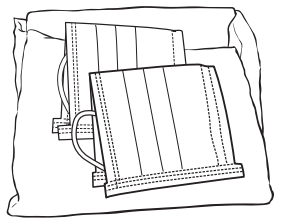
Figure 2. Dressing change kit
-
Put on the nonsterile gloves. Take off your old dressing by gently holding an edge of the dressing and slowly peeling it off your skin toward the exit site.
- As you peel the dressing back, put your thumb or index finger on the gel pad to hold your CVC in place and keep from pulling on it.
- To make the dressing easier to remove, you can wipe the area underneath the gel pad with an adhesive remover pad or use an adhesive remover spray.
- Make sure the whole gel pad comes off with the dressing.
- Without touching the area, inspect the exit site and your skin around it. If you’re changing your dressing yourself, it’s easiest to do this by looking in the mirror. If the exit site is red, raw, swollen, or has drainage or the area around your CVC is leaking, call your healthcare provider after you finish changing your dressing.
-
Open the white sterile paper drape to show the rest of your supplies. If your nurse gave you a different dressing or needleless connector to use, open its package so the dressing or needleless connector falls onto the sterile paper drape.
From this point on, do not touch your CVC or skin except with an alcohol pad. This will lower your risk of infection. - Wash your hands well with warm water and antibacterial soap or use the hand sanitizer packet on the outside of the dressing change kit.
-
Pick up the package with the sterile gloves. Be careful not to touch anything else on the sterile paper drape.
Put on the sterile gloves following the instructions in the resource How to Put on Your Sterile Gloves, touching only the inside of the sterile glove with your bare hand. After your gloves are on, be careful not to touch anything except the items on the sterile paper drape. - Take out the second sterile paper drape, unfold it, and place it on your work area. Move everything from the first sterile drape onto the second sterile drape.
- Open all the alcohol pads and take them out of their wrapping. Put the alcohol pads back onto the second sterile drape. Throw away the wrappers.
-
Pick up the ChloraPrep™ applicator with your dominant hand. Pinch the wings on the side together hard until you hear a click (see Figure 3).
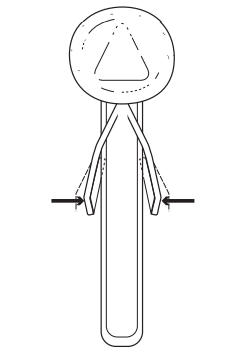
Figure 3. Chloraprep applicator
-
Pick up an alcohol pad in your nondominant hand. Use it to hold your CVC away from your chest (see Figure 4). Don’t touch the CVC itself. Only touch the alcohol pad.
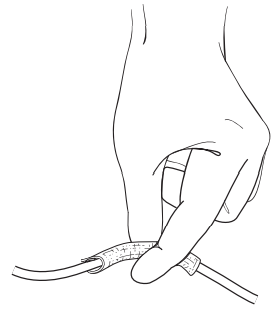
Figure 4. Holding the catheter
-
Starting at the exit site, scrub up and down and side to side with the Chlora-Prep in a 2-inch box around the exit site (see Figure 5). Scrub for 30 seconds. Throw away the ChloraPrep.
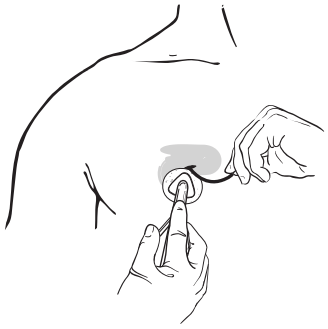
Figure 5. Cleaning the exit site
- Let the area air dry for at least 30 seconds. Don’t fan or blow on it. Keep holding your CVC away from your chest.
- Pick up another alcohol pad in your dominant hand. Use it to hold your CVC just above where the central catheter splits into lumens. Hold your CVC up and away from your chest.
-
Throw away the alcohol pad in your non-dominant hand and pick up a new one. Using the alcohol pad, gently wipe from the exit site to the end of a lumen (see Figure 6). Don’t pull on your CVC.
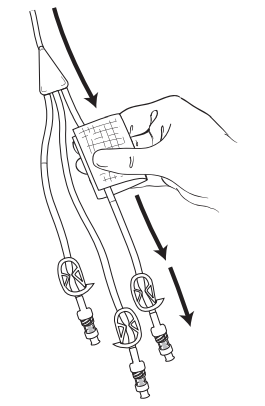
Figure 6. Cleaning the lumens
- Repeat step 19 for each of your lumens.
- Once you’ve cleaned all the lumens, you can stop holding your CVC away from your body.
- Apply the No Sting Barrier Film to your skin in the shape of a rectangle about the size of the dressing. Let it air dry completely. Don’t fan or blow on it.
-
Peel the backing off the dressing (see Figure 7). Position the dressing with the triangle shape over your CVC. Center the gel pad over the exit site and smooth down the dressing edges. Don’t stretch the dressing when you’re putting it on.
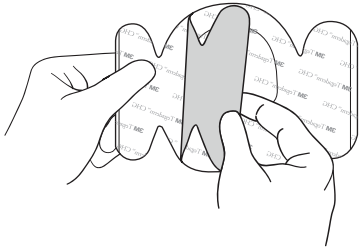
Figure 7. Tegaderm CHG dressing
-
Hold the round plastic tab on the outside and peel off the plastic all the way around the dressing (see Figure 8). Press on the outside of the dressing to make sure it’s fully stuck to your skin.
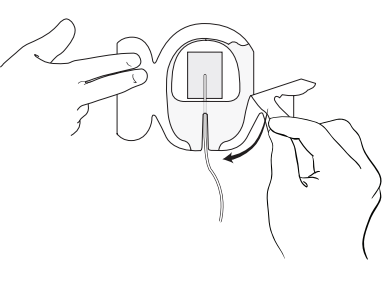
Figure 8. Applying the Tegaderm CHG dressing
You’re now done with the sterile part of the dressing change. Keep your gloves and mask on to change the needleless connectors and disinfection caps.
Changing your needleless connectors and disinfection caps
After you put on a new dressing, you’ll change the needleless connector and disinfection cap on each lumen of your CVC. Make sure you have 3 alcohol pads for each lumen.
If you’re changing your dressing because it’s damaged, loose, wet, or dirty, you don’t need to change your needleless connectors and disinfection caps unless they’re also dirty.
- Make sure the clamps on your lumens are closed.
-
Using an alcohol pad, hold the lumen with your nondominant hand close to, but not touching, the needleless connector (see Figure 9).
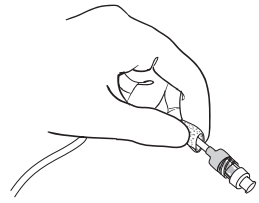
Figure 9. Holding the catheter
- Using your dominant hand, scrub the connection site for 15 seconds with another alcohol pad. Let it dry for 15 seconds.
- Twist off the old needleless connector. Throw away the old needleless connector and alcohol pad.
- Using your dominant hand, scrub the end of the lumen for 15 seconds with a new alcohol pad. Let it dry for 15 seconds.
-
Pick up a new needleless connector with your dominant hand. If it has a cover, remove it. Twist the new needleless connector onto the lumen (see Figure 10).
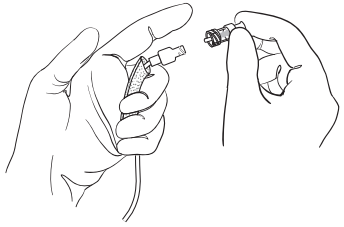
Figure 10. Twisting on the new needleless connector
- If you won’t be flushing your CVC right away, put a disinfection cap on the end of the needleless connector.
- Repeat steps 2 to 7 for your other lumens.
- Take off your mask and gloves. Throw them away.
-
Secure your CVC to protect it from being pulled. Your nurse will help you decide on the most comfortable way to do this. You can:
- Tuck it inside your bra (if you wear one).
-
Pin it to your clothing. To do this:
- Cut a 3-inch piece of paper tape.
- Fold the edges of the tape (see Figure 11). Leave enough sticky tape so you can wrap the tape around all your lumens.
- Gather the lumens with the sticky part of the paper tape. Put a safety pin through the folded edges and pin it to the inside of your clothing.
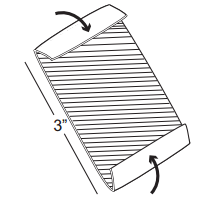
Figure 11. Paper tape
How to Flush Your CVC
A member of your care team will tell you if you need to flush your CVC. If you do, follow the steps below.
Supplies
- 10 mL syringe(s) prefilled with normal saline solution. You’ll need 1 syringe for each lumen.
- Nonsterile gloves
- 2 alcohol pads for each lumen
- 1 disinfection cap for each lumen
Steps to flushing your CVC
- Gather your supplies.
-
Clean your hands well.
- If you’re washing your hands with soap and water, wet your hands with warm water and apply antibacterial soap. Rub your hands together well for at least 20 seconds, then rinse. Dry your hands with a paper towel and use that same towel to turn off the faucet. If you don’t have paper towels, it’s OK to use clean cloth towels. Replace them when they’re wet.
- If you’re using hand sanitizer, be sure to cover all of your hands with it. Rub them together until they’re dry.
- Put on a pair of nonsterile gloves.
-
Release the air bubbles in the syringe. To do this:
- Hold the syringe so the tip is pointing upward.
- Gently tap the side. The air bubbles should rise to the top.
- Loosen but don’t remove the cap on the syringe.
- Press the plunger on the syringe until the air is pushed out.
- Retighten the cap.
- Pick up 1 lumen in your nondominant hand. If you have a disinfection cap, remove it. Using your dominant hand, scrub the end of the needleless connector with an alcohol pad for 15 seconds. Let it dry for 15 seconds.
- Remove the cap from the syringe. Throw away the cap. Keep holding the lumen away from your body and make sure nothing touches the clean end of the needleless connector while you’re doing this.
- Carefully push the syringe into the needleless connector and twist the syringe clockwise (to the right) until the connection feels secure.
- Unclamp the lumen. Before starting to inject the saline, make sure there aren’t any twists or other blockages in the tubing.
-
Use the push/pause method to flush your CVC.
- Quickly inject ⅓ of the saline. Pause.
- Inject another ⅓ of the saline. Pause.
- Inject the last ⅓ of the saline.
If you still can’t inject the saline, do not use extra pressure to flush the line. Follow steps 10 to 12 and then call your healthcare provider. - Reclamp the lumen.
- Turn the syringe counterclockwise (to the left) to disconnect it from the lumen. Throw it away.
- Attach a new disinfection cap to the end of the needleless connector.
Repeat steps 4 to 12 for each lumen. Once you’re done, throw away your mask and gloves. Wash your hands well with warm water and antibacterial soap or use hand sanitizer.
When to Call Your Healthcare Provider
Call your healthcare provider right away if:
- There’s redness, swelling, or drainage around your exit site
- You have a fever of 100.4 °F (38 °C) or higher
- Your catheter is broken or leaking
- Your needleless connector falls off
- There’s blood backing up into your catheter
- Your catheter becomes disconnected from your pump
- Your catheter is connected to a pump and the alarm on the pump is going off
- You have an unexplained problem with your catheter
Contact information
Monday through Friday from to , contact your healthcare provider directly.
After , during the weekend, and on holidays, call 212-639-2000. Ask for the pediatric doctor on call.